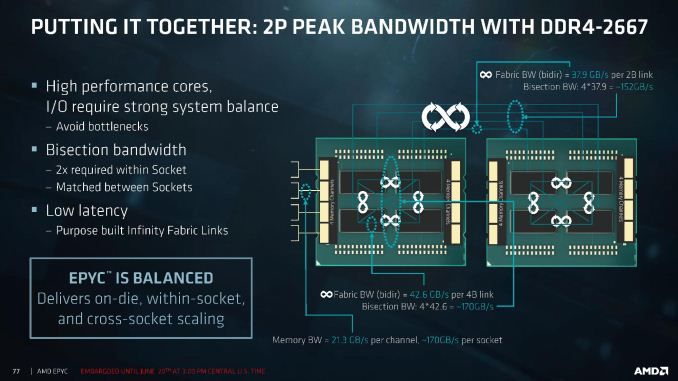AMD is going to put on sale its processors for the professional sector. And they will do so in the form of the Epyc 7000 series processors. AMD has announced these models so that companies will be able to choose from, for both single-sided and two-sided boards. The latter are the majority, with nine models versus three models for single-processor boards.
Epyc processors are quite large, as it includes four tablets in one package. Each of these pads has two core or CCX complexes of four physical cores each. So there are Epyc processors of up to 32 physical cores. These chips have multithreading, effectively doubling their number of cores. And each chip can handle two memory channels, for a total of 8 memory channels per processor per processor.
The different models have at least one physical core active by CCX. So the simplest model has eight cores in total. But there are also 16, 24 and 32 physical cores in these models. The prices, as you can see below, go from the 400 $ for Epyc 7251 to 4000 $ for Epyc 7601, without the TDP going in the clouds.
These processors manage memory up to 2667 MHz. And have the ability to manage up to 128 PCIe lanes for storage. There are two PCIe 3.0 x 16 per pin connections. That is an interesting fact in current data center sector. That is because the technology is migrating little by little to SSD storage in critical applications. AMD promises that these processors are up to 70% stronger than current Intel Xeon processors in dual processor layouts at the same price range.
EPYC 7000 Prices and Specifications
| AMD EPYC Processors (2P) | |||||||||
| Numbers / threads | Frequency (GHz) | L3 Cache | DRAM | PCIe | TDP | Price | |||
| Base | Turbo | Max. | |||||||
| EPYC 7601 | 32/64 | 2.2 | 2.7 | 3.2 | 64 MB | DDR4 octa-canal2666 MT / s | 8 x 16128 PCIe | 180 W | >4000$ |
| EPYC 7551 | 32/64 | 2.0 | 2.6 | 3.0 | 180 W | >3200 $ | |||
| EPYC 7501 | 32/64 | 2.0 | ? | 3.0 | 155 W
170 W |
||||
| EPYC 7451 | 24/48 | 2.3 | ? | 3.2 | 180 W | >2400 $ | |||
| EPYC 7401 | 24/48 | 2.0 | 2.8 | 3.0 | 155 W
170 W |
>1700 $ | |||
| EPYC 7351 | 16/32 | 2.4 | ? | 2.9 | 155 W
170 W |
>1100 $ | |||
| EPYC 7301 | 16/32 | 2.2 | ? | 2.7 | 155 W
170 W |
>800 $ | |||
| EPYC 7281 | 16/32 | 2.1 | ? | 2.7 | 155 W
170 W |
>600 $ | |||
| EPYC 7251 | 8/16 | 2.1 | ? | 2.9 | 120 W | >400 $ | |||
| AMD Epyc Processors (1P) | |||||||||
| EPYC 7551P | 32/64 | 2.0 | 2.6 | 3.0 | 64 MB | DDR4 octa-canal2666 MT / s | 8 x 16128 PCIe | 180 W | >2000 $ |
| EPYC 7401P | 24/48 | 2.0 | 2.8 | 3.0 | 155 W
170 W |
>1000 $ | |||
| EPYC 7351P | 16/32 | 2.4 | ? | 2.9 | 155 W
170 W |
>700 $ | |||
The Infinity Fabric interconnect is used to connect the pads of one of the processors. But is can connect to another processor on the same motherboard. In the first case it works at 42.6 GB/s per link. And in the second case it works at 37.9 GB/s per link, and four of these are used to connect the sockets, for a total of 151.6 GB/s.
The EPYC processors have a secure runtime environment, or SEV encrypted Segura to protect containers of interventions that modifies by other virtual machines or containers. They also have an AES-128 encryption engine directly attached to the memory management unit MMU.
75 Percent Higher Performance Per Watt
Regarding power consumption, these processors can consume more or less than indicated 15 W or a maximum of 20 W according to the needs of users. It regulates by two additional modes of use besides the standard, which is low consumption and high performance. It also includes various measures to detect times when to reduce power and adjust latency of operations. All in all, AMD also promises performance per watt up to 75% higher than that of an Intel Xeon of the same price range.
The company has updated its roadmap in the area of data centers. They indicate that around 2018-2019, they will arrive with a generation called Rome with Zen 2 cores manufactured at 7 nm. And around 2020 the Milan generation of Zen 3 will come with a process at 7+- nm.
